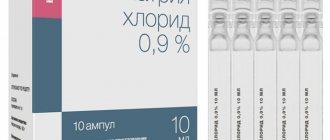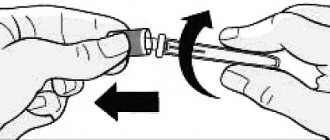Sterofundin isotonic 500 ml No. 10 bottle
Content
Pharmacological action Indications Dosage regimen Side effects Contraindications for use With caution Use during pregnancy and lactation Use for impaired renal function Use in children Use in elderly patients Special instructions Overdose Drug interactions Storage conditions Expiration date Sales conditions
pharmachologic effect
This drug is an isotonic solution of electrolytes with an electrolyte concentration adapted to the concentration of electrolytes in the blood plasma. It is used to correct extracellular fluid loss (i.e. loss of water and electrolytes in proportionate amounts). The introduction of the solution is aimed at restoring and maintaining the osmotic status in the extracellular and intracellular space.
The anion content is a balanced combination that eliminates metabolic acidosis.
Indications
replacement of extracellular fluid losses during isotonic dehydration, when there is a threat of acidosis or acidosis.
Dosage regimen
For intravenous administration only.
For single dosing only.
Unused solution must be discarded.
Only clear solutions that are practically free of inclusions are allowed to be used.
The solution must be administered using aseptic technique. The injection equipment must be completely filled with solution to ensure that no air can enter the system.
Adults, elderly people, adolescents and children: Dosage depends on the age, body weight, clinical and biological condition of the patient and concomitant therapy.
Recommended dosage:
- for adults, elderly and adolescents: from 500 ml to 3 l/24 hours, which corresponds to 1-6 mmol sodium/kg/24 hours and 0.03-0.17 mmol potassium/kg/24 hours.
- for children under 11 years of age: from 20 ml to 100 ml/kg/24 hours, which corresponds to 3-14 mmol sodium/kg/24 hours and 0.08-0.40 potassium/kg/24 hours.
Injection rate:
The maximum rate of administration is determined by the patient's fluid and electrolyte requirements, the patient's weight, clinical condition, and biological status.
For children, the average rate of administration is 5 ml/kg/h, but the rate depends on age: 6-8 ml/kg/h for children under one year old, 4-6 ml/kg/h for children under 2 years old and 2-4 ml/kg/h for children under 11 years of age.
General recommendations for the use of fluids and electrolyte solutions:
A level of 30 ml of solution per kg of body weight per day covers only the physiological needs of the body for fluid. In patients undergoing surgery and in resuscitated patients, fluid requirements increase due to decreased renal concentrating function and increased excretion of metabolites, which leads to the need to increase fluid intake to approximately 40 ml/kg body weight per day. Additional losses (fever, diarrhea, fistulas, vomiting, etc.) must be compensated for by even higher fluid intake, the level of which is determined individually. The actual individual level of fluid requirement is determined by sequential monitoring of clinical and laboratory parameters (urine output, serum and urine osmolarity, determination of excreted substances). The main replacement of the most important cations sodium and potassium reaches 1.5-3 mmol per kg/body weight per day and 0.8-1.0 mmol per kg body weight per day, respectively. Actual fluid therapy requirements are determined by electrolyte balance and monitoring of plasma electrolyte concentrations.
Side effect
If all precautions regarding doses and speed of administration are observed, side effects do not occur.
Contraindications for use
- hypervolemia;
- severe heart failure;
- renal failure with oliguria or anuria;
- severe general swelling;
- hyperkalemia;
- hypercalcemia;
- metabolic alkalosis.
Carefully
Large-volume infusions in patients with cardiac or pulmonary failure should always be performed with close monitoring.
Solutions containing sodium chloride should be administered with caution to patients with:
- mild or moderate heart failure, peripheral or pulmonary edema, or extracellular hyperhydration,
- hypernatremia, hyperchloremia, hypertensive dehydration, hypertension, renal dysfunction, eclampsia or the threat of its occurrence, aldosteronism and other conditions that occur during treatment with drugs (for example, corticosteroids), the use of which causes sodium retention.
Solutions containing potassium salts should be administered with caution to patients with heart disease or a predisposition to hyperkalemia due to renal or adrenocortical failure, acute dehydration or extensive tissue destruction, which occurs in severe burns.
Due to the presence of calcium:
precautions must be taken to prevent hemorrhage during intravenous infusion,
the solution should be administered with caution to patients with impaired renal function or diseases accompanied by increased concentrations of vitamin D, such as sarcoidosis.
after a blood transfusion, the solution should not be administered using the same infusion set
Solutions containing metabolizable anions should be administered with caution to patients with respiratory problems. Monitoring of serum electrolytes, fluid balance, and pH is necessary.
Use during pregnancy and breastfeeding
There are no data on the use of Sterofundin Isotonic during pregnancy and lactation. With constant monitoring of the volume of infusion, the concentration of electrolytes and the acid-base balance, complications do not arise when using the drug according to indications.
Sterofundin Isotonic should be used with caution in cases of toxemia of pregnancy.
Use for renal impairment
Renal failure with oliguria or anuria is a contraindication to the use of the drug.
Take with caution if you have impaired renal function.
Use in children
Adolescents and children: Dosage depends on the age, body weight, clinical and biological condition of the patient and concomitant therapy.
Use in elderly patients
Elderly: Dosage depends on the age, body weight, clinical and biological condition of the patient and concomitant therapy.
special instructions
The solution has a pH of 4.6-5.4 and a theoretical osmolarity of 304 mOsm/L. Therefore, it can be injected into peripheral veins. If administration is by rapid infusion under pressure, all air must be removed from the plastic bag and infusion set before infusion begins, otherwise there is a risk of air embolism.
Fluid balance, plasma electrolyte concentrations, and pH should be closely monitored during the infusion. Sterofundin isotonic can be administered for as long as required to replace the volume.
Overdose
Volume overload and electrolyte overdose:
Symptoms:
An overdose of the drug can lead to phenomena such as hypertensive overhydration, electrolyte disturbances, and pulmonary edema.
Therapy:
The infusion should be stopped immediately and diuretics should be prescribed with constant monitoring of plasma electrolytes; correction of electrolyte balance.
Drug interactions
Sodium, potassium, calcium and magnesium are contained in Sterofundin Isotonic in the same concentrations as in plasma. Therefore, the use of Sterofundin Isotonic in accordance with the indications and contraindications does not lead to an increase in the concentrations of these electrolytes. If the concentration of any of the electrolytes increases for other reasons, the following incompatibilities must be taken into account
Sodium incompatibilities:
Corticosteroids and carbenoxolone have the ability to retain sodium and water (with the appearance of edema or hypertension).
Potassium incompatibilities:
Suxamethonium
Potassium-sparing diuretics (amiloride, spironolactone, triamterene)
Tacrolimus, cyclosporine
may increase plasma potassium concentrations, leading to potentially fatal hyperkalemia, especially in renal failure.
Calcium incompatibilities:
With hypercalcemia, the effect of digitalis glycosides may be enhanced, which can lead to severe cardiac arrhythmia with possible death. Vitamin D may cause hyperacalcemia.
Storage conditions
Store at a temperature not exceeding 25° C out of the reach of children. Do not freeze.
Best before date
3 years.
Terms of sale
For use in hospitals.
Compound
1000 ml of solution contains (active substance):
- sodium chloride 6.80 g;
- potassium chloride 0.30 g;
- magnesium chloride hexahydrate 0.20 g;
- calcium chloride dihydrate 0.37 g;
- sodium acetate trihydrate 3.27 g;
- L-malonic acid 0.67 g.
Electrolyte concentration:
- sodium - 145 mmol/l;
- potassium - 4 mmol/l;
- magnesium - 1 mmol/l;
- calcium - 2.5 mmol/l;
- chlorides - 127 mmol/l;
- acetates - 24 mmol/l;
- malate - 5 mmol/l.
Excipients: water for injection, sodium hydroxide.
Note!
Description of the drug Sterofundin ISO solution for inf. cont. 500ml No. 10 on this page is a simplified author’s version of the apteka911 website, created on the basis of the instructions for use.
Before purchasing or using the drug, you should consult your doctor and read the manufacturer's original instructions (attached to each package of the drug). Information about the drug is provided for informational purposes only and should not be used as a guide to self-medication. Only a doctor can decide to prescribe the drug, as well as determine the dose and methods of its use.
Storage conditions
Store at a temperature not exceeding 25°C, out of the reach of children. Do not freeze.
Shelf life: 3 years.
Expiration date after opening the container. From a microbiological point of view, the drug should be used immediately after opening. If the solution is not administered immediately, the person using this drug is responsible for storing it properly until the next use, which should usually not exceed 24 hours at a temperature of 2-8°C, unless the solution has been reconstituted under controlled and proven aseptic conditions. divorced
Product description certified by the manufacturer B. Brown
.
Verified by
Likar Turumkulova Irina
Features of application
Pregnant
There are no data on the use of Sterofundin ISO in pregnant and breastfeeding women. Within the recommended indications, no risk should be expected if the volume of injected solution, electrolyte levels and acid-base parameters are carefully monitored.
"Sterofundin ISO" should be used with caution in cases of toxicosis in pregnant women.
Drivers
Sterofundin ISO has no or negligible effect on the ability to drive a car or operate machinery.
Overdose
Excessive or too rapid administration of the solution can lead to water or sodium overload with increased skin turgor, venous stagnation and the development of edema, especially in cases of impaired sodium excretion by the kidneys. In this case, additional hemodialysis may be required.
Treatment
Stop the infusion immediately. Further treatment depends on the nature and severity of symptoms and may include the administration of diuretics with frequent monitoring of electrolyte balance, correction of electrolyte and acid-base imbalances.
Side effects
Signs of overdose may appear.
Hypersensitivity reactions, including urticaria.
Possible overhydration, pulmonary edema, electrolyte disorders.
Although oral administration of magnesium salts stimulates peristalsis, paralytic ileus has been reported in rare cases following administration of magnesium sulfate.
Adverse reactions may be related to the injection technique, including febrile response, infection at the injection site, local pain or local reactions, venous irritation, venous thrombosis or phlebitis extending from the injection site, and extravasation. Adverse reactions may also be due to medications added to the solution; the nature of the substances added will determine the type of any other adverse effects.




